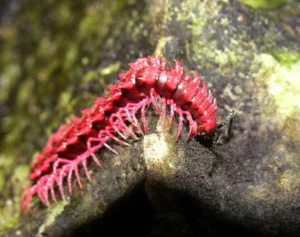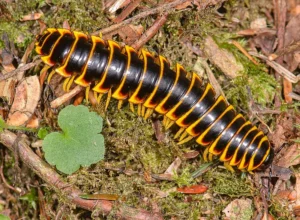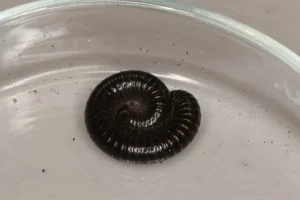Diplopoda is the class of arthropods that includes millipedes. The number of millipede species worldwide exceeds 12,000 according to MilliBase. Let us see few examples of them.
- Archispirostreptus gigas
- Desmoxytes purpurosea
- Sierra luminous millipede
- Oxidus gracilis
- Harpaphe Haydeniana
- Trigoniulus Corallinus
- Glomeris sublimbata
- Narceus Americanus
- Pneumodesmus newmani
- Apheloria Virginiensis
- Illacme Plenipes
- Trichopetalum Whitei
- Procyliosoma Tuberculatum
- Polyxenus Fasciculatus
- Cylindroiulus Caeruleocinctus
- Tachypodoiulus niger
- Ommatoiulus sabulosus
- Flat-Backed Millipedes
- House and Garden Millipedes
- Brown or Black Millipedes
- White or Red Millipedes
Archispirostreptus gigas
Archispirostreptus gigas is also called giant African millipede or Shongololo, the largest of all millipedes. They have a length that ranges from four inches to one foot. Their legs count from 300 to 400. Found in rain forests of Africa. Their rounded body can sometimes be brown or black in color.
Desmoxytes purpurosea
Desmoxytes purpurosea, also named pink dragon millipedes, are popular for their spiky projections. The name is due to the vivid pink color that is because of the hydrogen cyanide produced by their glands. It is toxic to its predators. These are only present in northern Thailand.

Sierra luminous millipede
Genus of millipedes producing cyanide is known as motyxia. Many of the millipede species together are are called the Sierra luminous millipedes. They are blind and cyanide is produced by glands. They can naturally glow brightly, thus, they are bioluminescence. Found in South Sierra Nevada and mountains of California.
Oxidus gracilis
Oxidus gracilis or greenhouse millipedes are native to Japan and are only found alive indoors or yard for not many days. They feed on decomposing organic matter like leaves. Size ranges from 18 to 23 mm in adults and widths maybe 2 to 2.5 mm. They have brown color and legs of pale cream color.
Harpaphe haydeniana
Harpaphe haydeniana is popularly called yellow-spotted millipede that are seen in moist forests from Southeast Alaska to California along the Pacific Ocean. They have a dark color with yellow-tipped keels. In order to defense they are able to produce toxic hydrogen cyanide. Adults can be of 4–5 cm.
Trigoniulus corallinus
Trigoniulus corallinus is a species that is globally seen in the Indo-Malayan areas that include India, Sri Lanka and China. They are sometimes known as the rusty millipede or common Asian millipede. These millipedes are commonly found in areas that are moist, few rotten woods and sometimes compost.

Glomeris sublimbata
Glomeris sublimbata is tiny and oval structured. They can be of 20 mm long. Their body is divided into 12 segments. They may or may not have eyes. Males and females can be differentiated by number of leg pairs: males have 19 and females have 17. Last pair of leg in adult males is called telopods.
Narceus americanus
Narceus americanus also named American giant millipede or iron worm. Found in coast of North America. Their gray body is cylinderical and size can be 100 mm. They are detritivores, usually feeds on decaying wood and leaf litter at night. They are also found to feed on deer scat and fresh fruit.
Pneumodesmus newmani
Pneumodesmus newmani species have only one, long fragment of paranota (keels) which is of 1 cm. Their body is divided into six segments. Three rows of approximately hexagonal bosses and a horizontal bar decorate the dorsal section of each section (bumps).
Apheloria virginiensis
Apheloria virginiensis also called Kentucky flat millipede, found in North America. They produce toxic cyanide to protect themselves. Cyanide irritates eyes if rubbed. They act as host to Arthrophaga myriapodina, a parasitic fungus, that causes affected people to ascend to higher spot before dying.

Illacme plenipes
Illacme plenipes is considered as siphonorhinid millipede that is seen in central area of the U.S. state of California. They can have about 750 legs. They have comparatively small bodies. Adult females can grow up to 3 cm whereas adult males are a bit smaller in size and have smaller number of legs.
Trichopetalum whitei
Trichopetalum whitei is commonly known as the Luray Caverns blind cave millipedes. They are the rare troglobitic (obligate cavernicolous) millipede. They do not possess any eyes and are white in color, that is, they are unpigmented millipede.
Procyliosoma tuberculatum
Procyliosoma tuberculatum, is a giant pill millipede that is native to New Zealand. They can be of length 5 cm and width of 2.5 cm wide. They feed on decomposing plants usually at night. To protect themselves from predators they curl up their hard, shiny body. The females can lay up to 6 eggs.
Polyxenus fasciculatus
Polyxenus fasciculatus is about 2 mm (0.079 in) in length. The bristles have barbs throughout the length of them that force them to interlink and grappling hooks at the tip that lock on to the setae of ants. They are seen in the east region of United States, Caribbean Islands and Canary Islands.
Cylindroiulus Caeruleocinctus
Cylindroiulus Caeruleocinctus belongs to family named Julidae. The size of this kidney shaped millipede ranges from 20 to 30 mm. Its segments are a combination of brown and black color. Commonly present nearby residential areas with leafy vegetation such as parks, small forest regions and bushes.

Tachypodoiulus niger
Tachypodoiulus niger commonly called white-legged snake or black millipede. They are especially seen on chalky and limestone soils. They possess cylinder like body that is black in color. Consist of 100 pairs of white legs. Their body is divided into 41–56 segments. They feed on algae, raspberries.
Ommatoiulus sabulosus
Ommatoiulus sabulosus commonly called striped millipede, native to Europe from family named Julidae. They are cylindrical, plump and brown color that can be recognized by ginger stripes all over body segments. They are mostly seen in sandy areas during daytime, and they usually hide under old logs.
Flat-Backed Millipedes
The size of these flat-backed millipedes’ ranges from 3mm to 130mm. They have tiny pairs of legs from the lower body portions but no eyes.
House and Garden Millipedes
During daytime, house and garden millipedes seek cover beneath wet, dark, rotting things. Although they are innocuous, some may have a fondness and choose them as backyard pets. They barely affect agricultural well-being. They do not attack and damage people much with their defensive secretion.
Brown or Black Millipedes
Brown or black millipedes are generally present in North America. They are calm, dwell in solitude under dead trees and bushes, and are occasionally seen in backyards of houses.
White or Red Millipedes
White or red millipedes are vividly colored organisms which have peculiar anosmatic coloring that serves as a protective mechanism to alert predators of the deadly compounds produced by them when these millipedes are touched.
Conclusion
Millipedes and snails are both common garden pests that can cause damage to plants. Millipedes are known for their voracious appetites, and they will often eat the roots of plants, which can damage the plant. There are various species that are considered giant millipedes and kept as pets.
Read more about Tapeworm.
Also Read:
- Polycarpic plant example
- Parasitic fungi examples
- Plant cell wall formation
- Does splicing occur in prokaryotes
- Bioindicator examples
- How is adenine formed
- Mesophilic bacteria examples
- Fungi parasites examples
- Nucleoside its important structural properties
- Unsaturated fat examples

Hi, I am Milanckona Das and pursuing my M. Tech in Biotechnology from Heritage Institute of Technology. I have a unique passion for the research field. I am working in Lambdageeks as a subject matter expert in biotechnology.
LinkedIn profile link-